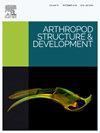Excretory glands of sea spiders (Pycnogonida, Nymphonidae)
IF 1.7
3区 农林科学
Q2 ENTOMOLOGY
引用次数: 0
Abstract
All major arthropod taxa possess excretory glands — a type of filtration nephridium considered ancestral for this group. Pycnogonids form a basal branch of the arthropod phylogenetic tree and are ancient aquatic chelicerates, but they were believed to lack specialised excretory organs, except for Nymphopsis spinosissimum (Ammotheidae). Whether this condition is unique or common remained unknown due to lack of anatomical data for many species. Here we examined four nymphonids: Nymphon brevirostre, Nymphon grossipes, Nymphon serratum and Pentanymphon antarcticum using scanning and transmission electron microscopy, as well as light microscopy. In adults of all four species, we found excretory organs and describe ultrastructural details of all their parts: sacculus, reabsorption channel, excretory channel and the pore. In addition to the definitive (adult) excretory organs, we also detected some larval and juvenile transitory ones and were able to trace the origin of the sacculus podocytes from the non-epithelial mesoderm of the horizontal septum. All excretory organs are located in the appendages of the first three postocular segments of the cephalosoma (although not necessarily in all of them at once) because these areas can maintain the high hemolymph pressure necessary for ultrafiltration. The ultrastructure and development of the sacculus point toward the secondary nature of this cavity, although the coelomic status of the sacculi in sea spiders and other arthropods is still unclear.

海蛛(海蛛科,海蛛科)的排泄腺。
所有主要的节肢动物类群都有排泄腺——一种被认为是该类群祖先的滤过肾。pynogonids形成节肢动物系统发育树的一个基础分支,是古老的水生螯足动物,但它们被认为缺乏专门的排泄器官,除了Nymphopsis spinosissimum (Ammotheidae)。由于缺乏许多物种的解剖数据,这种情况是独特的还是常见的仍然未知。本文采用扫描电镜、透射电镜和光学显微镜对四种蛱蝶进行了研究:短蛱蝶、长蛱蝶、serratum和Pentanymphon antarcticum。在这四个物种的成虫中,我们都发现了排泄器官,并描述了它们所有部分的超微结构细节:小囊、重吸收通道、排泄通道和孔。除了确定的(成虫)排泄器官外,我们还发现了一些幼虫和幼虫的暂时性排泄器官,并能够从水平隔膜的非上皮中胚层追踪到小囊足细胞的起源。所有的排泄器官都位于头三个脑瘤后节的附属物中(尽管不一定同时在所有的附属物中),因为这些区域可以维持超滤所必需的高血淋巴压力。尽管小囊在海蜘蛛和其他节肢动物中的体腔地位尚不清楚,但小囊的超微结构和发育表明该腔的次要性质。
本文章由计算机程序翻译,如有差异,请以英文原文为准。
求助全文
约1分钟内获得全文
求助全文
来源期刊
CiteScore
3.50
自引率
10.00%
发文量
54
审稿时长
60 days
期刊介绍:
Arthropod Structure & Development is a Journal of Arthropod Structural Biology, Development, and Functional Morphology; it considers manuscripts that deal with micro- and neuroanatomy, development, biomechanics, organogenesis in particular under comparative and evolutionary aspects but not merely taxonomic papers. The aim of the journal is to publish papers in the areas of functional and comparative anatomy and development, with an emphasis on the role of cellular organization in organ function. The journal will also publish papers on organogenisis, embryonic and postembryonic development, and organ or tissue regeneration and repair. Manuscripts dealing with comparative and evolutionary aspects of microanatomy and development are encouraged.

 求助内容:
求助内容: 应助结果提醒方式:
应助结果提醒方式:


